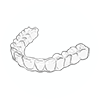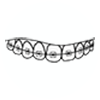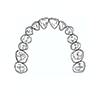Root Canals in Lilburn GA
The words “root canal” can strike fear into the hearts of mortal men. With modern techniques, most root canals can be performed with little or no pain. The first concern is proper diagnosis. No one wants to undergo root canal treatment – painless or not – only to find out that it was unnecessary. This is why it is best to know that our experienced and highly credentialed dentists at Killian Hill Dental Care will do the best job of detecting the source of your problem.
Some types of tooth pain can be reversible without resorting to a root canal. Removing decay and placing a sedative filling will sometimes do the trick. If there is pain along the “gum line”, we can apply a desensitizer to the root to see if the condition improves. When one goes to the dentist with a toothache, it is not unusual for the culprit to be another tooth. This is called referred pain and it’s very important that the dentist performs a number of tests to determine the exact source. It is extremely important that the patient doesn’t take any kind of analgesic, such as ibuprofen or Tylenol, before an appointment. This can mask the symptoms and skew the diagnostic tests that the we perform. Another possibility is that the pain could be coming from something other than a tooth. During spring and fall, it is very common here in Atlanta for patients to appear in our office with “toothaches” only to find out that it was sinusitis. Taking adequate time during the diagnostic phase can save much time, money, and discomfort by getting it right the first time.
Root canal dentist in Lilburn GA, Dr. Richard P. Gangwisch, DDS, MAGD, ABGD, Dr.
Richard Gangwisch performs a root canal on an actual patient. Dr. Gangwisch performs root
canal treatment in Lilburn, Snellville, Lawrenceville and surrounding communities of Gwinnett
County.
Root canals are not the scourge of dentistry like they used to be. By using good local anesthesia techniques, a root canal can be performed with little to no discomfort. A root canal is done by first placing an opening into the pulp chamber. This is a hollow area in the center of the tooth where the dental pulp (a collection of nerves and blood vessels) resides. Once access to the pulp chamber has been obtained, we will clean out any debris, whether it is live nerve tissue or dead, necrotic material. At this point, the actual root canal(s) are located. These are tiny channels that go through the root and exit at the end to communicate with the bone. Sometimes these canals can be very torturous to negotiate and many times requires a dentist with many years of experience to successfully complete the process. Our dentists have successfully completed thousands of root canals. The canals are meticulously cleaned by a series of “files”, pin-like instruments. With each successive file, it will clean the walls of the canal, then the debris is flushed out with a sodium hypochlorite irrigating solution. Removing all organic deposits is tantamount in allowing for a good final seal. Any leftover pieces of debris will contaminate the filling material and cause it to leak and fail prematurely. An irrigating solution is important to not only help flush debris from the canal during the cleaning process, but to also provide final disinfection of the canal before it is filled. Sodium hypochlorite, the main ingredient in common household bleach, makes an ideal irrigating solution. It will emulsify living tissue so that it can easily be flushed from the canals. This is especially important when working in canals that have lots of nooks and crannies for vital and non-vital tissues to hide. When an oxygenating agent is added it will bubble out hiding debris that cannot be mechanically removed with the thin files that the dentist uses to clean and shape the canals. It is important that the irrigant stay within the confines of the root canal space so as to not cause peripheral tissue damage. Once the irrigant has done its job, it is dried up with points of absorbent paper, but it still has the residual effect of disinfection before the root canals are filled. The dried canals are then filled with a sealer and an inert material called gutta percha. The root canal has now been completed, hopefully without pain, and is ready for restoration.
Once a root canal has been completed, it is extremely important that the tooth be properly restored. If not, then there would be a good chance that the tooth could be lost permanently. The reason for this is the dental pulp which houses a collection of nerves and blood vessels in the center of the tooth will bathe the inner tooth layer (the dentin) with fluid, allowing the tooth to flex under load. Once the source of the moisture is gone, the tooth becomes very brittle. We always recommend that all chewing teeth have a crown placed soon after a root canal has been completed. We have even had the unfortunate experience of needing to extract a tooth only weeks after root canal treatment due to the tooth fracturing through to the root because it had not been properly restored yet. Some front teeth, if they have adequate remaining tooth structure, can be restored with just a filling.
To place a crown on a back tooth, usually a crown buildup needs to be done. A crown buildup is a core of filling material that is used to replace the tooth structure that was lost in the root canal process and due to decay. This core may need to be retained with pins or a large post that is placed in one of the canals. With a quality, well-timed final restoration covering and protecting a root canal tooth, that tooth should give decades of future service.
If you are contemplating any type of orthodontic treatment or cosmetic dentistry, don’t hesitate to make an appointment for
a FREE consultation with our extremely experienced and credentialed Lilburn dentists at Killian Hill Dental
Care. Call
 770-923-3966 today.
770-923-3966 today.






















 770-923-3966
770-923-3966